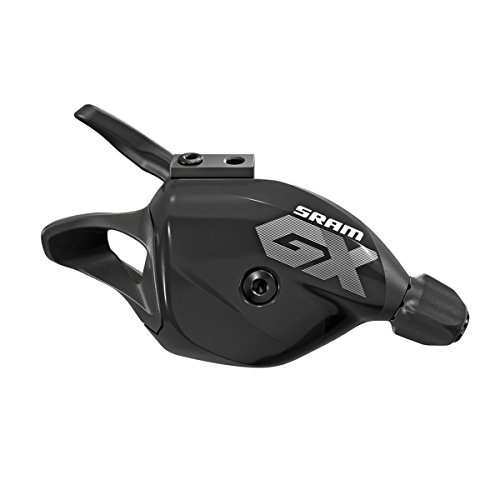Introduction
In this blog post we’re going to be talking about the SRAM SX and GX range of mountain bike groupsets and providing you with the information you need to decide which one will suit you best.
It’s safe to say that if you’re into mountain biking, you’ll have definitely heard of SRAM’s range as they are one of the most popular products available, but perhaps you didn’t necessarily know the difference between them.
On the other hand, if you’re new to the world of mountain biking and want to know more before making a purchase, we highly recommend that you carry on reading.
Before we head into the main article, we thought it might be great to give you a little background information about SRAM. They have been around since 1987 and produce a huge range of mountain biking products and components, including suspension forks, hydraulic disc brakes, and dropper seat posts.
They really are a great company who are renowned for great quality products and put an emphasis on sustainability and reducing their environmental impact.
Now we’ve given you a brief introduction into the world of SRAM, let’s take a look at the SRAM SX And GX in a little more detail.
Overview of SRAM SX
Features and Specifications
Here’s a breakdown of the SRAM SX’s features and specifications:
Drivetrain: 1×12. This is designed to cope with a wide variety of riding styles and is a great option for those looking to take part in different types of adventures on their bike. Another benefit of using this system is that it helps to avoid chain slippage and provides more novice riders with confidence when tackling different terrains.
Speeds: 12-speed.
Price: Somewhere in the region of £250 / $300 but can be as expensive as £300 / $350.
Durability and performance: The SRAM SX offers excellent performance for its price point, however, whilst the durability is fine, it isn’t as good compared to the GX.
I had a SRAM SX system in place on a previous mountain bike and it coped excellently with the range of riding I undertook in my local area.
If I had to say something negative about it, the durability was perhaps on the low side, however, this does depend on how much you’re riding as to how long it will last.
Overview of SRAM GX
Features and Specifications
Here’s a breakdown of the SRAM GX’s features and specifications:
Drivetrain: 1×12. This is designed to cope with a wide variety of riding styles and is a great option for those looking to take part in different types of adventures on their bike. Another benefit of using this system is that it helps to avoid chain slippage and provides more novice riders with confidence when tackling different terrains.
Speeds: 12-speed.
Price: Somewhere in the region of £380 / $480 but can be as expensive as £500 / $640. Check latest price on Amazon.
Durability and performance: For me, this is what sets the GX apart from the SX – it is built with much better-quality materials and therefore you can expect a much better level of durability and much better precision and accuracy when shifting between gears.
The type of system would certainly be better for more experienced cyclists who are looking for a higher level of performance.
Other areas to consider: SRAM SX vs GX
So I’ve gone through most of the technical specifications and other important details, but I just thought I’d quickly cover some of the other points that you might like to know about.
Here are some key questions and answers that should provide everything else you need to know.
Is the SRAM SX and GX built out of different materials?
Yes, they are. As the SX system is substantially cheaper than the GX system it is made up of materials such as steel and plastic, whereas the GX is made up of aluminum.
Is there a difference in gear ranges between the two systems?
Yes, there is a slight difference. The SRAM SX system offers a 500% range and the GX system offers a 520% range.
Is there a significant difference in weight between the two systems?
We know that weight can play a huge role in cycling – each tiny gram can make all the difference on the climbs and descents! The SRAM SX comes in at 2600 grams and the GX comes in at 2,440 grams.
Cassette range: Something a little bit more obscure, but important for those who want to know. The SRAM SX system uses a cassette range of 11-50 teeth and the GX system uses a range of 10-52 teeth.
Price and Value Proposition
We have covered the price higher up in the article, but we just wanted to reiterate that the SRAM SX system is definitely more focused on those on a budget, recreational riders, or riders those just getting into cycling, but don’t be fooled by the price – you can expect a solid piece of kit if you decide to go with the SRAM SX system.
Alternatively, you can go for the SRAM GX system which will cost more money, and for that you can expect to get higher quality parts and therefore higher performance, but it is also still reasonably priced against competitor models.

Ideal User Profiles For Each Groupset
SRAM SX
This option would be great for those who are looking to upgrade their existing setup to something a little bit more reliable, or perhaps those who are newer to mountain biking.
The SRAM SX would also suit those who have a limited budget and also someone who enjoys cycling but wants something to easy to use.
I have never personally owned a 1×12 drivetrain, but my father-in-law had one on his Trek Marlin and he preferred the ease of shifting gears over one chain-ring and not having to move between different chains.
SRAM GX
I think the best way to think about the SRAM GX is like an upgrade to the SRAM SX. You’re going to have to pay more money for it but you can expect upgraded performance and more durability for the extra expense.
Perhaps if you’ve already used the SRAM SX upgrading to the GX would be a good option, or if you are a more experienced rider who needs something that will perform better.
Conclusion and Recommendations

Without knowing an individual’s riding preferences, where they’re going to be riding, the amount of riding they’ll be doing and the budget they have available, it’s almost impossible to recommend a certain setup.
However, to summarise, we have put together some information on the pros and cons of each system to help you make an informed choice.
SRAM SX
| Pros | Cons |
| The main pro here is the price point – the SRAM SX comes in at a very good price, and provides excellent value for those looking for a basic upgrade to their mountain bike. | |
| The SRAM SX is going to suit the majority of people – it performs excellently and will be suitable for many types of different riders. | The SRAM SX may not be best suited to higher level riders, or those who are looking to compete or set PB’s. The SRAM GX would be more suitable in this instance. |
| The SRAM SX system is reliable – this is one of the main selling points for me personally. Reliability on a long ride up in the mountains is something that everyone should be looking for from their bike setup. | |
| Because of the basic set up using the 1×12 drivetrain it is simple and easy to use. | Some people may want an extended range of gears to help them navigate certain parts of a ride. |
| Less precision than the SRAM GX. |
SRAM GX
| Pros | Cons |
| Even though the SRAM GX is more expensive than the SX we’re still counting this as a pro because it is still very competitively priced against some of its competitors. | We’ve had to mention that it’s more expensive than the SX, but remember you will be getting better performance from the GX setup. |
| The SRAM GX is perfectly suited for those who are mountain biking at a higher level. | The SRAM GX may not be suited to the everyday rider and might be better for those with a higher level of skill. |
| The SRAM GX is top notch for reliability, performance and durability. | |
| It offers smooth and clean shifting between the gears. | |
| Brilliant precision at shifting between gears. | |
| The SRAM GX system comes in at a lighter weight than its SX counterpart. |
As you can see from all the information we’ve provided, both the SRAM SX and GX are both fantastic options for your mountain bike and if you choose to buy either, you won’t be disappointed.
Happy riding!

Mike is an experienced road cyclist and mountain biker and splits his time between the two disciplines. In his spare time he can often be found tackling the big hills and mountains of mid-Wales, attempting to beat his previous times






